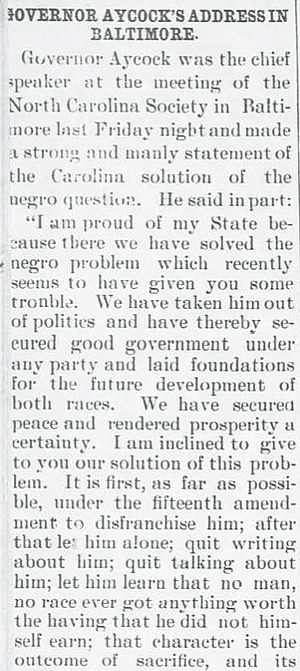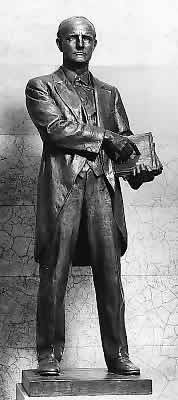Charles Brantley Aycock facts for kids
Quick facts for kids
Charles Brantley Aycock
|
|
|---|---|

Charles Aycock, from The World's Work
|
|
| 50th Governor of North Carolina | |
| In office January 15, 1901 – January 11, 1905 |
|
| Preceded by | Daniel Lindsay Russell |
| Succeeded by | Robert Broadnax Glenn |
| United States Attorney for the Eastern District of North Carolina | |
| In office 1893–1897 |
|
| President | Grover Cleveland |
| Preceded by | Charles A. Cooke |
| Succeeded by | Claude M. Bernard |
| Personal details | |
| Born | November 1, 1859 Wayne County, North Carolina, U.S. |
| Died | April 4, 1912 (aged 52) Birmingham, Alabama, U.S. |
| Cause of death | Heart attack |
| Nationality | American |
| Political party | Democratic |
| Alma mater | University of North Carolina at Chapel Hill |
| Occupation |
|
Charles Brantley Aycock (November 1, 1859 – April 4, 1912) was the 50th Governor of the U.S. state of North Carolina. He served from 1901 to 1905. He started his career as a lawyer and teacher. He became active in the Democratic Party during a time when the South mostly voted Democratic. He was known for supporting racial segregation.
Aycock became known as "the Education Governor." He strongly supported improving North Carolina's public schools. After his time as governor, he traveled around the country to promote education.
Contents
Early Life and Career
Charles B. Aycock was born in Wayne County, North Carolina. He was the youngest of 10 children. His family lived near the town of Fremont, North Carolina. Even though his father died when Charles was 15, his mother and older brothers made sure he could go to college.
Aycock attended the University of North Carolina, which is now the University of North Carolina at Chapel Hill. He joined a debate club there. In 1880, he graduated with top honors in speaking and writing. He then started working as a lawyer in Goldsboro. He also taught school to earn more money. Because he was good at both, he became the superintendent of schools for Wayne County. He also served on the school board in Goldsboro.
His political career began in 1888. He was chosen to be a presidential elector for Grover Cleveland. He became known as a good speaker and debater. From 1893 to 1897, he worked as a U.S. attorney for the Eastern District of North Carolina.
White Supremacy Campaigns
In 1898 and 1900, Aycock played a big role in the Democratic Party's "white supremacy" campaigns. These campaigns aimed to keep white people in power and limit the rights of African Americans.
A state report talks about Aycock's involvement with the Wilmington insurrection of 1898. This event involved planned violence to suppress African American and Republican communities. It led to bloodshed. Speakers like Aycock and Alfred Moore Waddell constantly talked about white supremacy. This made people very excited, even after the election was won. Aycock was not in Wilmington on the day of the violence.
In 1899, the state legislature, which was mostly Democratic, passed a change to the state constitution. This change made it harder for African Americans to vote. It added a poll tax (a fee to vote) and a literacy test (a reading and writing test). It also included a grandfather clause. This clause allowed poor white voters to avoid the new rules if their grandfathers had voted before 1866. Aycock supported this change. He urged lawmakers to let people vote on it in August instead of November.
In the same election, Aycock ran for governor against Republican Spencer B. Adams. During his campaign, his supporters sometimes showed a rapid-fire gun from the Wilmington event. Aycock often appeared with Red Shirts, who were groups that used violence and intimidation to support white supremacy.
Aycock believed that African Americans should not vote. He said that white people needed to "disfranchise the negro" (take away their right to vote). He claimed this would help both races develop.
In the 1900 North Carolina gubernatorial election, the voting change was approved, and Aycock was elected governor. He reportedly won 60% of the votes. However, there was some voter fraud. In some counties, more votes were counted for Aycock than there were eligible voters.
Aycock as Governor
As governor, Aycock became known as the "Education Governor." He strongly supported the public school system. It is said that a new school was built in North Carolina almost every day he was in office. He was inspired to support education after seeing his mother sign a document with an "X" because she could not write.
Aycock believed that real social improvement needed education. He supported:
- Higher salaries for teachers.
- Longer school terms.
- New school buildings.
- About 690 new schoolhouses were built, including 599 for white students and 91 for Black students.
While he helped build schools for Black students, Aycock also believed that their education should be controlled by white people. He thought this would help Black people fit into a "subordinate role" in society.
Aycock believed that white people were "thoroughbreds" and would always be ahead of Black people. He thought that if Black schools were reduced, many Black people would leave the state. He also said that North Carolina needed more workers, so it was important not to make mistakes in dealing with the Black population, who did a lot of the hard labor.
Historians have noted that Aycock's support for Black education was also a way to prevent the federal government from interfering with the laws that took away Black people's voting rights. He worried that if North Carolina seemed to be keeping Black people uneducated, the federal courts might overturn both the voting restrictions and the racial segregation of taxes.
Aycock also supported other progressive changes as governor. These included:
- Building roads.
- Increasing taxes on corporations.
- Creating new rules for railroads.
- Passing laws about child labor and temperance (limiting alcohol).
He fought against lynching (mob killings) as governor. However, he also expanded the state's convict leasing program. This system forced prisoners, many of whom were Black, to work for private businesses. It was a form of forced labor.
Views on Race and Society
On December 18, 1903, while he was governor, Aycock gave a speech in Baltimore. The speech was called "The Negro Problem." In it, he shared his ideas on keeping Black people separate and preventing them from participating in government. He aimed to get around the Fifteenth Amendment, which guarantees the right to vote for all men.
This speech was given about two months after a book also called The Negro Problem was released. That book was written by important Black scholars like W.E.B. DuBois and Booker T. Washington. They wrote about the challenges faced by Black people after slavery.
Aycock's speech is one of his most famous and controversial. He said he was proud of North Carolina because it had "solved the negro problem." He believed that by taking Black people out of politics, the state had achieved good government and peace.
He suggested that Black people should be "disfranchised" as much as possible under the Fifteenth Amendment. After that, he said, they should be left alone. He believed Black people needed to earn their own way through hard work and obedience to the law. He also stated that there should be "unending separation of the races." He believed the two races could develop side by side but should never mix.
Aycock also said that white people had a duty to Black people. He believed white people brought Black people to America and that Black people had served them well. He felt white people owed Black people gratitude and justice. He said white people should educate Black people and give them a fair chance. However, his idea of a "fair chance" was within a system of racial separation.
Later Life and Death
After leaving the governor's office in 1905, Aycock went back to being a lawyer. In 1912, he was asked to run for a Senate seat. But before the election could be decided, Aycock died. He had a heart attack while giving a speech to the Alabama Education Association in Birmingham on April 4, 1912.
He was speaking about "Universal Education" when he suddenly stopped, threw up his hands, and fell.
Legacy and Changing Views

For many years, Charles Aycock was seen as a hero in North Carolina. Many places were named after him:
- In Greensboro, North Carolina: an auditorium at UNC Greensboro, a street, a neighborhood, and a middle school.
- Dormitories at UNC-Chapel Hill and East Carolina University.
- A high school in Pikeville.
- An elementary school in Henderson.
- An elementary school in Asheville (the plaque was removed in 2020).
- A high school in Cedar Grove (closed in 1963).
- A street in Chapel Hill.
- A junior high school in Raleigh, North Carolina (absorbed into William G. Enloe High School in 1979).
- A street in Raleigh's Five Points neighborhood.
In a 1933 textbook, Aycock was called "one of the best friends that colored people had." For most of the 20th century, historians and politicians in North Carolina saw him as an admirable figure. This is why a statue of him was chosen to represent North Carolina in the National Statuary Hall Collection in Washington, D.C.
However, in recent years, this view has been challenged. People now look more closely at Aycock's role as a leader in the white supremacy campaigns of 1898 and 1900. These campaigns involved widespread violence, voter intimidation, and voter fraud. They even led to a coup d'état (overthrow of the government) in Wilmington.
These campaigns had big effects:
- Black people were removed from voter lists using literacy tests.
- Jim Crow laws (laws that enforced racial segregation) became common.
- The Democratic Party controlled North Carolina politics for a long time.
Because of his ties to white supremacy, many places named after Aycock have been renamed:
- In 2011, the N.C. Democratic Party removed Aycock's name from its annual fundraiser.
- In 2014, Duke University removed his name from a residence hall.
- In 2015, East Carolina University trustees voted to remove his name from a residence hall.
- In 2016, UNC Greensboro's Board of Trustees voted to remove his name from the auditorium.
- In 2015, the Guilford County school board voted to rename Aycock Middle School in Greensboro.
- In 2017, the Greensboro City Council voted to rename the Aycock Historic District.
- In 2018, North Carolina governor Roy Cooper asked for Aycock's statue in the U.S. Capitol to be replaced with one of evangelist Billy Graham.
- In 2018, Greensboro City Council voted to rename Aycock Street to Josephine Boyd Street, after the first Black student to attend the all-white Greensboro High School.
- In 2021, Raleigh City Council voted to rename Aycock Street to Roanoke Park Drive.




